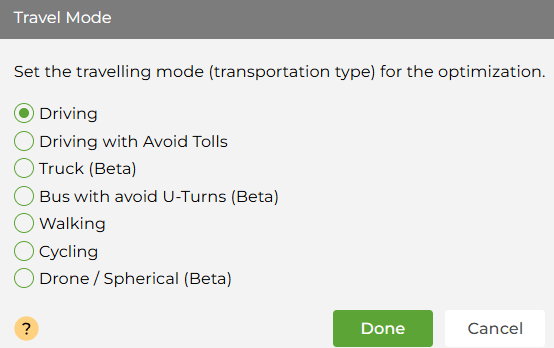What to Consider when Setting a Travel Mode
There are several Travel Modes available with MyRouteOnline Route Planner.
The default mode of travel is Driving but these are all the options you can use*:
-
Driving – Best routes for driving cars, vans, etc
Avoid Tolls – Best routes avoiding roads with toll fees
Truck – Best routes for driving trucks and other big vehicles
Bus/Service Vehicles – Best routes for driving with stops at the same side of the street, avoiding U-Turns
Walking – Best routes for walking, using sidewalks
Bicycling – Best routes for bicycles, using bike lanes
Drone – Best straight-lines routes
Avoid Tolls
Routes are calculated using toll free roads. This was usually done via the MyRoute app, during navigation process but now available during the route planning process as well.
Commercial Truck Routing
Size and Weight Restrictions: Routes are calculated to avoid roads with weight limits, bridge heights, or narrow passages that trucks cannot safely navigate.
Truck-Specific Roads: Routes may prioritize roads designated for truck traffic.
Turn Restrictions: Routes consider restrictions on large vehicle turns.
Toll Roads: Toll costs and truck-specific toll rates may be factored in.
Businesses relevant to Truck Mode:
- Long-haul trucking
- Freight delivery
- Logistics and supply chain management
- Any route that a big rig, or other large commercial vehicle would take
Bus/Service Vehicle Routing
Bus Lanes: Routes may prioritize bus lanes to optimize travel time.
Stop Locations: Routes are designed to include designated bus stops or service locations.
Passenger Capacity: Routes may consider passenger capacity and accessibility requirements.
Low bridge clearance: Like trucks, busses can be very tall, so low bridge clearance is important.
Businesses relevant to Bus/Service Vehicle Mode:
- Public transportation (bus routes)
- Shuttle services
- Waste Management
- Emergency services (ambulances, fire trucks)
Drone Routing
Routes are calculated as the crow flies, meaning the direct, straight-line distance between points without considering roads, obstacles, or terrain.
Businesses relevant to Drone Mode:
- Last Mile deliveries
*Switching between Travel Modes consumes new credits.
